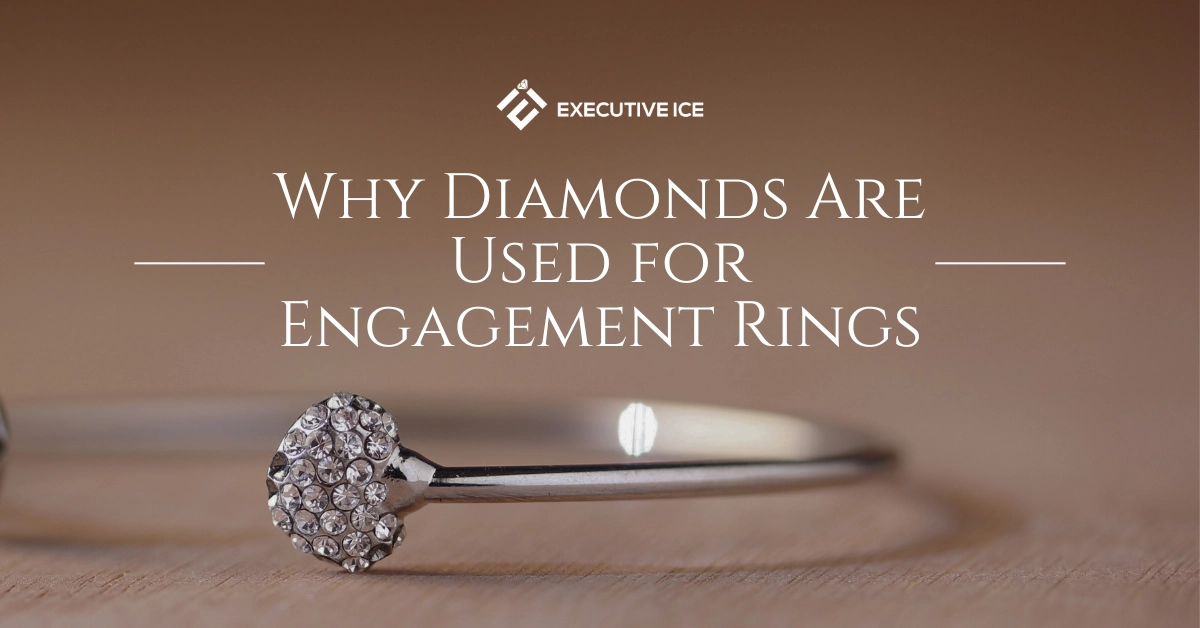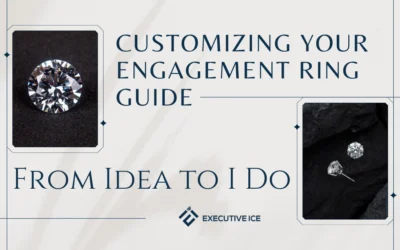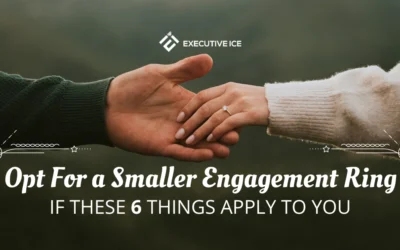Ever pondered why the diamond has become the heart of every engagement ring? And why our evaluation of such a precious piece of jewelry hinges not on the choice of the gemstone but rather on the quality and size of the diamond we can afford?
The engagement ring has an intriguing evolution that might surprise you. It all began in the days of Rome when the act of engagement was symbolized by the exchange of simple iron rings. Over time, preferences began to shift towards the more precious metal, gold, with the 12th century witnessing an increased emphasis by the church on the engagement period and the tradition of exchanging rings.
The Evolution of the Engagement Ring
By the late 19th century, engagement rings had taken on a rather practical avatar in the United States. Some women received thimbles — a decidedly unglamorous item — which they subsequently transformed into wearable rings by cutting them.
Despite these varied iterations, none of them sparkled with the fiery brilliance of a diamond. So how did the humble engagement ring become the diamond-studded symbol of love and commitment it is today? What transpired in the 20th century that elevated diamonds from a luxury to a necessity in engagement rings?
The perception that diamonds are the only suitable choice for an engagement ring is deeply ingrained in our collective consciousness. But have you ever questioned why? What’s the story behind the diamond’s crowning glory, and how has history contributed to its undeniable status in the realm of engagement rings?
Contrary to popular belief, the diamond engagement ring is less a time-honored tradition and more the outcome of an incredibly effective marketing strategy. The real game-changer was De Beers, a dominating force in the diamond industry. In the late 1930s, they launched a marketing campaign that, quite literally, set the diamond standard. This brilliant move succeeded in embedding the idea of diamond engagement rings not only into our minds but also into the very fabric of our societal traditions.
So, the next time you see a diamond engagement ring, remember: this glittering symbol of love is not just a testament to timeless romance, but also to the power of marketing. It’s a fascinating narrative that ties together history, societal norms, and commercial ingenuity — all nestled within the shiny contours of that much-desired diamond.
And the folks at Mental Floss were gracious enough tackle this question:
In 1938, De Beers’ execs were in a bit of a tight spot. Diamond demand and prices had been on a slow decline since 1919, and the tanking economy had led consumers to favor more modest rings that included intricate metalwork rather than gems. The cartel needed to tap into a new market to jumpstart its revenues. De Beers approached New York ad agency N.W. Ayer for help convincing Americans that they desperately needed diamonds.
The agency’s campaign was undoubtedly one of the most effective of all time. N.W. Ayer embarked on a multi-pronged attack that completely overhauled Americans’ view of diamonds. The agency got Hollywood’s biggest stars to wear diamonds and encouraged leading fashion designers to talk up diamond rings as an emerging trend. The plan worked beautifully; in the first three years of the campaign American diamond sales shot up by over 50 percent. Read more…
Remember, it was the De Beers company that ingrained the notion of spending two months’ salary on a diamond engagement ring. This “rule” served to bolster their profits significantly, establishing a high spending benchmark for this symbol of commitment.
But the magic didn’t end there. In collaboration with the N.W. Ayer advertising agency, De Beers introduced another game-changing idea to the world.
In 1947, the enchanting slogan “A Diamond is Forever” was crafted by Frances Gerety, a talented copywriter at Ayer. The phrase was so compelling and resonated so deeply that it continues to be associated with De Beers even after almost 75 years.
Need tips on How to Craft the Perfect Marriage Proposal? Or seeking The Complete Guide on Finding the Perfect Engagement Ring? We’ve got you covered!
This immortal slogan helped portray the diamond as the ultimate, everlasting symbol of love. The result? Diamond engagement ring sales skyrocketed, and within two decades, a staggering 80% of American brides were flaunting their dazzling diamonds.
Diamonds for Engagement Rings: The 21st Century
And that brings us to the present moment, possibly the reason why you’re reading this article today!
As the craving for diamond engagement rings has surged, so have the stakes in this glitzy market.
Case in point: In 2010, Blue Nile, a prominent online diamond retailer, launched a ring-buying app and made headlines by selling a ring worth $250,000 to a user on an iPad.
Fast forward to 2022, and such a transaction might not raise as many eyebrows. But a decade ago, it was a groundbreaking occurrence that shook the diamond retail industry!
Why Women LOVE Diamonds?
We’re all familiar with the phrase “Diamonds are a girl’s best friend”. This sentiment likely emerged from a time when marriage was seen as a virtuous achievement for women – a notion that still lingers today, though not as prevalently.
In the modern era, many women are embracing singlehood and choosing not to have children. Despite this shift in societal norms, the enchantment of a fairy-tale wedding endures, and the allure of having a sparkling diamond ring on one’s finger remains as potent as ever.
Yet, despite the deep-rooted affection for diamonds, few individuals comprehend why these precious stones have become synonymous with engagement rings. To understand this, let’s delve into some historical context.
Tracing the Origin
Diamond rings, despite their contemporary reputation of glitz and glamour, haven’t always been viewed positively. Initially, engagement rings were symbols of ownership rather than love. Husbands presented their wives with gold rings for public appearances, but at home, wives wore plain metal rings, signifying their husbands’ ownership.
The narrative surrounding diamond rings began to shift when diamonds were discovered in South Africa. De Beers, a major diamond company, astutely marketed these gemstones as the quintessential engagement stone that every woman ought to have. Thus, the memorable slogan “diamonds are forever” was born.
However, the diamond’s dazzling journey wasn’t without hurdles. The Great Depression caused a significant decline in diamond sales, but this slump was temporary. As the economy revived, De Beers initiated a second aggressive marketing campaign, promoting diamonds as symbols of eternity and perfection. This strategy brilliantly exploited psychological cues, despite the fact that diamonds, like everything else, are breakable.
The turning point arrived when De Beers began encouraging socialites and celebrities to flaunt diamonds. Soon, the diamond ring evolved from a mere marketing creation to an emblem of wealth and success, creating a new aspirational standard.
Modern Day Engagement Rings
In today’s world, diamond engagement rings are highly revered across a variety of cultures. However, their symbolism has evolved significantly from the past. No longer seen as a mark of ownership, diamond engagement rings now represent commitment and partnership.
In terms of style, the landscape has also transformed. A myriad of colors are available, breaking the age-old norm of the traditional white diamond ring.
A prime example of this shift in taste is Kate Middleton’s famous sapphire engagement ring. This ring, originally gifted by Prince Charles to Princess Diana, features a stunning sapphire encased in smaller white diamonds. Its value, both historical and monetary, is a subject of much speculation and intrigue.
Interestingly, the evergreen appeal of diamond rings has seen a slight decline in recent years. This can be partly attributed to their lofty price tags, which many younger individuals find challenging to afford. Whether it’s due to lower incomes, fewer accumulated assets, or simply the rising cost of living, the financial implications of buying a diamond are a significant consideration for today’s generation.
In contrast, diamonds are becoming increasingly popular among the burgeoning middle classes in countries like India and China.
Another factor contributing to the changing diamond market is the growing popularity of lab-created diamonds. These are up to 40% cheaper than mined diamonds, offering a more affordable alternative without compromising on sparkle.
Furthermore, diamonds’ reputation has been somewhat tarnished due to concerns about ethical sourcing, a subject highlighted in the movie ‘Blood Diamonds.’
The film depicts the harrowing experiences of Africans forced to extract diamonds under harsh conditions, instigating global discussions about responsible diamond sourcing.




